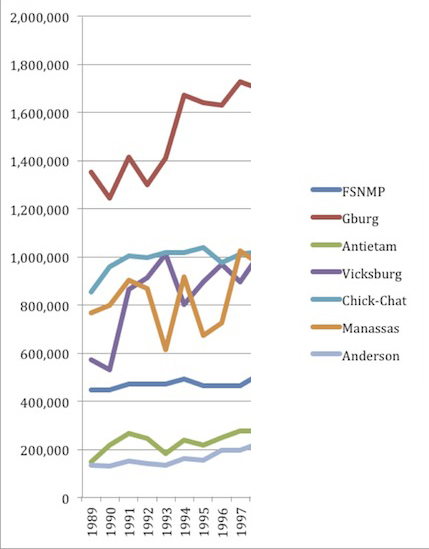The Ken Burns Effect
Lest anyone underestimate the importance of Ken Burns’ The Civil War, take a second to study this graph:

The Civil War had such a tremendous impact on the American psyche that visitation at Civil War battlefields spiked the season after its release. Ken Burns did for the Civil War in one eleven-hour film what thousands of history teachers across America could never do (despite some very good intentions and efforts): The Civil War made people pay attention to The Civil War. It made them care about it. It made them fall in love with it.
The film revolutionized documentary-making, too: gorgeous, patient shots of beautiful landscapes…primary source material voiced by recognizable actors…close-up examination of period photographs. Burns found so many ways to let the documents and the battlefields tell the story. David McCullough’s narration certainly helped, too, as did that wonderful, wonderful soundtrack.
The fact that Burns tried to tell America’s greatest story in only eleven hours amazed me, and the fact that he did it so well impressed me. Sure, he left plenty out and he gave perfunctory treatment to other things. He tamed Ed Bearrs and he over-relied on Shelby Foote (but with Foote’s charm and voice, wouldn’t you, too?). Burns’ interpretive lenses are not focused on the same things scholars today focus on. And maybe he did this, that, or the other thing, too.
His final product was nonetheless incredible—artful, moving, and personal in a way most “pure” history fails to be.
And look at the results.
The Civil War brought people to the battlefields and inspired them to buy books. Suddenly, opportunity existed for hundreds of historians to reach hundreds of thousands of visitors that otherwise never would have stepped onto their sites or into their museums and bookstores. Many of those people have been coming back over and over, ever since.
 I recently paid a return visit to the First Manassas battlefield. Rather than pay my respects to my old friend Stonewall, I walked in the footsteps of the 2nd Rhode Island Infantry. The sun burned red in the east and vanished even as the full moon rose from between two tall cedars. In July of 1861, the Rhode Islanders swept across this ground, losing a pair of their officers in the process. One of them, Sullivan Ballou, had written a poignant letter home to his wife just days earlier, reflecting on his own possible death.
I recently paid a return visit to the First Manassas battlefield. Rather than pay my respects to my old friend Stonewall, I walked in the footsteps of the 2nd Rhode Island Infantry. The sun burned red in the east and vanished even as the full moon rose from between two tall cedars. In July of 1861, the Rhode Islanders swept across this ground, losing a pair of their officers in the process. One of them, Sullivan Ballou, had written a poignant letter home to his wife just days earlier, reflecting on his own possible death.
Who has seen The Civil War and not been moved by Ballou’s letter? Who cannot walk the ground there and not think of that scene—and likewise not be moved?
Here. Here is where it happened.
And that remains the enduring legacy—the enduring gift—of Ken Burns’ The Civil War: It moves people and brings them here.
“Forgive my many faults, and the many pains I have caused you,” Ballou wrote to his wife. Perhaps critics of The Civil War could offer Burns that same sort of grace, because in the end, he succeeds at far, far more than he fails at.
He moves people and brings them here.
Hello Chris– I echo and applaud your comments. I watched almost all of the original Ken Burns series when it came out 25 yrs ago– my how time flies! In the interim, having more time during my retirement, I have read extensively about the Civil War including series by Bruce Catton and Shelby Foote. So, I’m now able to watch The New Ken Burns upgrade with new “eyes” and appreciation.
Regarding upticks in visitations and interest following the Burns TV series and your subsequent comments, I’m reminded of a jazz analogy. The late jazz record producer Gus Statiras was a good friend to many. He helped produce some jazz parties Pensacola, Atlanta, San Diego and others. His comment: “If you just depended in the hard-core jazzfans, we’d all go broke!” So, congratulations to Ken Burns ( and you, too, Chris) for whetting interest of the masses on the periphery!
Chris – It is neat to see the “bump” effect on a graph. I don’t fault Ken Burns in the least for any of the errors in the film made 25 years ago or for over-relying upon Shelby Foote because he was going for artistry, storytelling, and accuracy. I’m amazed at how many Civil War images he did use from a variety of sources. What I’m interested in is enticing the folks who really are getting hooked on the 150+ year old photographs to check out the Center for Civil War Photography and to read articles, like this one, which may expand their thinking about what can be learned from many of the photographs: https://abrahamlincolnatgettysburg.wordpress.com/2015/09/11/the-civil-war-by-ken-burns-a-new-birth-of-freedom/